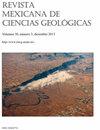城市垃圾建设植物生长技术的可行性
IF 0.5
4区 地球科学
Q4 GEOSCIENCES, MULTIDISCIPLINARY
Revista Mexicana De Ciencias Geologicas
Pub Date : 2020-11-24
DOI:10.22201/cgeo.20072902e.2020.3.1583
引用次数: 6
摘要
可持续城市发展的另一种选择是通过建造种植园和恢复退化的土地来重建城市。这项工作的目的是描述墨西哥城产生的城市废物的特征,并评估它们在构建植物生长技术方面的潜力,作为在不影响自然景观的情况下用于城市重建的替代方案。以墨西哥城绿地园艺废弃物为原料,对建筑和拆迁废弃物进行了不同施用量的堆肥改性试验。配制了9种混合物;三种基于混凝土,三种基于拆迁垃圾,三种基于开挖垃圾。在为期12个月的试验中,监测了这些混合物的物理、化学和物理化学性质的变化,即养分含量、保水性和通气性。还对可溶性部分的矿物学特征和重金属、微量元素释放风险进行了评价。所构建的技术溶胶或多或少适合于番茄植株的生长。土壤pH值和土壤电导率是决定其适宜性的主要因素;由于盐的洗涤作用,这两个参数随着时间的推移而改变。矿物材料的粒度以及在建造Technosols时使用的堆肥的施用量导致了足够的持水能力和植物生长所需的土壤通气性。亲本材料的类型决定了Technosol的大部分特性,以及它们作为植物支持物的能力。可利用的重金属和微量金属的浓度对植物生长没有限制。然而,在进一步的研究中,应考虑这些元素与可溶性有机物的潜在共转运。本文章由计算机程序翻译,如有差异,请以英文原文为准。
Feasibility of urban waste for constructing Technosols for plant growth
An alternative for sustainable urban development is to revegetate cities with the construction of planters as well as to recover degraded sites. The objective of this work was to characterize urban waste materials produced in Mexico City and to evaluate their potential for constructing Technosols for plant growth, as an alternative to use in revegetating the city without affecting natural landscapes. Construction and demolition waste materials amended with different application rates of compost made out of gardening wastes from Mexico City green areas were tested. Nine mixtures were prepared; three based on concrete, three based on demolition waste and three based on excavation waste. Changes on physical, chemical and physicochemical properties of these mixtures, namely nutrient contents, water retention and aeration capacity, were monitored in a twelve-month experiment. The mineralogy and the risk regarding the release of heavy metals and trace elements were also evaluated in the soluble fraction. The constructed Technosols were appropriate, to a greater or lesser extent, for tomato plant growth. Soil pH and soil electrical conductivity (EC) were the main factors defining their suitability; both parameters changed over time due to the washing of salts. The particle size of the mineral materials as well as the application rates of compost used in the construction of the Technosols resulted in adequate water holding capacity and soil aeration for plant growth. The type of parental materials defined the majority of the Technosol characteristics as well as their ability to function as a plant support. The concentrations of readily available heavy and trace metals were not a limitation for plant growth. However, potential co-transport of these elements with soluble organic matter should be considered in further research.
求助全文
通过发布文献求助,成功后即可免费获取论文全文。
去求助
来源期刊

Revista Mexicana De Ciencias Geologicas
地学-地球科学综合
CiteScore
1.00
自引率
12.50%
发文量
0
审稿时长
6-12 weeks
期刊介绍:
Revista Mexicana de Ciencias Geológicas (RMCG) publishes original research papers on geological processes of broad interest, and particularly those dealing with regions of Latin America. The RMCG also publishes review papers on topics of current interest, and on the geology and tectonics of geological provinces of Latin America. Besides, it offers the opportunity for host editors to publish special thematic issues.
 求助内容:
求助内容: 应助结果提醒方式:
应助结果提醒方式:


